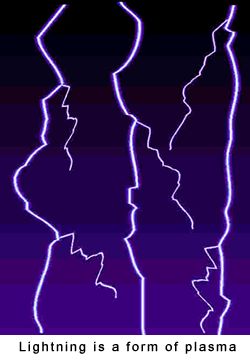BACKGROUND:
Chemistry is an underlying component of most branches
of the sciences. All substances can be described by their chemical behaviors
and chemical compositions. All "things" are classified as matter.
Everything on Earth can be easily described in terms of one of four forms of
matter: solid, liquid, gas, and plasma. Students are familiar with the three
common forms of matter: solids, liquids, and gases. A solid is an object
that has a form. Its form will not change if the solid is picked up, put in
a container, or touched. A liquid is a substance which flows, spreads out,
or will fall from your hand if you try to hold it. Liquids take the shape of
the containers in which they are placed. A gas is a substance that moves
around and fills the container that encloses it. Gases will continue to try
and fill up an area even if that area is the size of a room. Outside, gases
will expand indefinitely. Plasma is a fully ionized gas containing roughly
equal numbers of positively and negatively charged atoms. Plasma is actually
the most common form of matter in the Universe, but most children are not
familiar with it. The best way to describe plasma for a kindergarten student
is to demonstrate plasma by showing the students a "plasma" ball,
which generates a plasma. Remember not to confuse blood plasma with this
plasma. Blood plasma and plasma the state of matter are two very different
things.
There is also a fifth state of matter called the Bose-Einstein
Condensate. This form of matter only is observed under extremely cold
conditions not found naturally on Earth. Scientists are currently learning
more and more about how matter can be described in other conditions that are
not normal on the Earth’s surface. The Bose-Einstein Condensate is
difficult to explain at this time. We suggest that you may mention that
other states of matter exist, and that the students will learn more about
them in higher grades.
PROCEDURE:
- Explain to the students that there are four states of matter; solid,
liquid, gas, and plasma. Tell them that a fifth state of matter, Bose-Einstein
Condensate, also exists, but that they will not study it in
kindergarten.
- Ask your students to find some objects in the class that are solids.
Hopefully they will pick up a book or pencil. Ask them why these objects
are solids. The objects are solids because their shapes do not change
when touched. Point out other solids in the room.
- Make sure you have a glass of water on your desk when you ask students
to find a liquid. If the students are having a difficult time finding a
liquid, hold the glass of water and either swirl the water so the
students can see that it flows or pour some on your hand to show some
properties of liquids. Discuss other examples of liquids like milk or
honey.
 Next, have the
children place their hands in front of their faces and blow onto their
hands so that they feel air. Ask them if this is matter. They may not
fully realize that air is matter, because it is a gas that takes up
space. Air is a mixture of many types of gases and although air cannot
be seen (unless it is very cold), it is everywhere on the Earth’s
surface. Discuss other examples of gasses like helium in a balloon,
steam from a tea kettle, or any other familiar examples. Next, have the
children place their hands in front of their faces and blow onto their
hands so that they feel air. Ask them if this is matter. They may not
fully realize that air is matter, because it is a gas that takes up
space. Air is a mixture of many types of gases and although air cannot
be seen (unless it is very cold), it is everywhere on the Earth’s
surface. Discuss other examples of gasses like helium in a balloon,
steam from a tea kettle, or any other familiar examples.
- Explain that plasma is not easy to see, but it is all around us. Tell
them that you have a special device called a plasma ball, which you will
use to demonstrate plasma.
Turn on the ball and invite the children to look at the plasma
discharging on the sides of the glass. Touch the glass and ask the
students to tell you what they see. They will probable say "a
lightening bolt". Explain that the plasma is attracted to your
finger. It is best not to allow the students to all touch the plasma
ball as this can lead to small shocks.
If you don’t have a plasma ball, show students a flourescent bulb.
The light it generates is actually a glowing plasma.
- Give each child a balloon and ask them to think of different types of
substances that can be used to fill up the balloon. If you have a helium
balloon, you may want to bring it in to show the children that there are
different types of gases, some lighter than others. You can also put
water into a balloon, which would be the liquid state of matter. You may
want the student to blow up the balloon several times, so that water
will form at the tip of the balloon.
- Have the students color the balloon picture in the workbook. Have them
determine how many states of matter are in the picture. The balloons in
this coloring exercise illustrate two of the four states of matter
(solid and gas). The actual balloon is a solid and the air inside is a
gas. Some students may say plasma is also present even though we can't
see it.
|